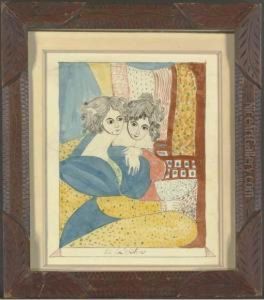Mary Ann Willson Paintings
Mary Ann Willson is an enigmatic figure in the history of American art, primarily because very little is known about her life, including her years of birth and death. What is known is that she was active as a painter around 1810 in the Hudson Valley region of New York State. Willson is often categorized as a folk artist, a term used to describe self-taught or minimally trained artists who create works outside of the academic tradition.
Mary Ann Willson's work came to public attention when a group of watercolor paintings was discovered in the 1940s that were attributed to her. These paintings primarily depict scenes of rural life, including landscapes and domestic activities, and are notable for their detailed and vibrant portrayal of early 19th-century country life. Her style is characterized by a naive charm and a strong sense of composition, which has attracted the interest of art historians and collectors alike.
Despite the recognition of her talent, very little is known about Willson's personal life or artistic training. She is sometimes mentioned in connection with a companion, Miss Brundage, with whom she is believed to have lived in a same-sex relationship. This aspect of her life, however, is also not well-documented and is based on limited historical records.
Because of the lack of concrete information, Mary Ann Willson remains a somewhat mysterious figure. The scarcity of biographical details has made it challenging for scholars to fully assess her place within the broader context of American art history. Nevertheless, the surviving works attributed to her provide valuable insights into American folk art of the early 19th century and continue to be studied and appreciated for their aesthetic and historical significance.
